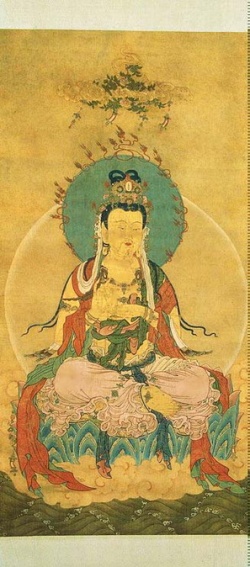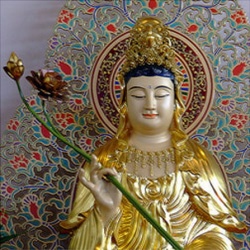Mahasthamaprapta (Shih Chih, Seishi)
Mahasthamaprapta (Shih Chih, Seishi) One of the three sages in Pure Land Buddhism, recognizable by the water jar (jeweled pitcher) adorning Her crown. Usually represented in female form in East Asian iconography. Amitabha Buddha is frequently depicted standing between the Bodhisattvas Avalokitesvara and Mahasthamaprapta.
Mahāsthāmaprāpta is a bodhisattva mahāsattva that represents the power of wisdom, often depicted in a trinity with Amitābha and Avalokiteśvara (Guanyin), especially in Pure Land Buddhism. His name literally means "arrival of the great strength". Mahāsthāmaprāpta is one of the Eight Great Bodhisattvas in Mahāyāna Buddhism, along with Mañjuśrī, Samantabhadra, Avalokiteśvara, Akasagarbha, Kṣitigarbha, Maitreya and Sarvanivarana-Vishkambhin.
In Chinese Buddhism, he is usually portrayed as a woman, with a likeness similar to Avalokiteśvara. He is also one of the Japanese Thirteen Buddhas in Shingon. In Tibetan Buddhism (Tantrism), Mahāsthāmaprāpta is equated with Vajrapani, who is one of his incarnations and was known as the Protector of the Buddha. Mahāsthāmaprāpta is one of the oldest bodhisattvas and is regarded as powerful, especially in the Pure Land school, where he takes an important role in the long Sutra of Infinite Life. He is also associated with the temple guardians Kongo Rikishi across Japan.
In the Shurangama Sutra, Mahāsthāmaprāpta tells of how he gained enlightenment through the practice of Buddha recitation, or continuous pure mindfulness of Amitābha, to obtain samādhi. In the Contemplation Sutra, Mahāsthāmaprāpta is symbolised by the moon while Avalokiteśvara is represented by the sun.
Mahasthamaprapta (Sanskrit, "One Who Has Obtained Great Power") awakens in humans their need to be liberated from Samsara. In Pure Land Buddhism he is often paired with Avalokiteshvara in association with Amitabha Buddha; Avalokiteshvara enacts Amitabha's compassion, and Mahasthamaprapta brings to humanity the power of Amitabha's wisdom.
Like Avalokiteshvara, Mahasthamaprapta is sometimes depicted as male and sometimes as female. He may have a lotus in his hand or a pagoda in his hair. In Japan he is called Seishi.
One of two main attendants to Amida Buddha, appearing frequently in artwork known as the Amida Sanzon阿弥陀三尊 (lit. = Amida Triad). Seishi is typically placed to the right of the central Amida image, but sometimes (e.g., Immeasurable Life Sutra) Seishi appears on the left.
One of 25 Bodhisattva who descent from heaven (raigō) with Amida to welcome dying souls into Amida’s Pure Land
One of the Thirteen Deities (Jūsanbutsu) of the Shingon sect invoked in memorial services for the departed.
One of the Eight Great Bodhisattva (Hachi Daibosatsu or Hachi Bosatsu) who appear in the Taizōkai Mandala and Butsugen Mandala.
Guardian of People Born in Zodiac Year of the Horse.
In Tibetan Buddhism, Mahāsthāmaprāpta (aka Seishi) is equated with Vajrāpani (aka Niō).
In Tibet, Vajrāpani is considered an incarnation (manifestation) of Seishi.
Seishi appears in early Mahayana sutras, including the Immeasurable Life Sutra, the Meditation Sutra, and the Lotus Sutra. Seishi did not gain great popularity in India, but in China and Japan, Seishi's importance grew with the spread of the Pure Land sects devoted to Amida Buddha, for Seishi is one of the two main attendants (kyōji 脇侍) of Amida Buddha. The other is Kannon. In Japan, the three appear in a popular grouping known as the Amida Sanzon 阿弥陀三尊 (lit. = Amida Triad), with Amida in the center, Seishi to the right (representing wisdom), and Kannon to the left (representing compassion). Even today, the Pure Land sects of Japan are among the nation’s largest and most popular. Nevertheless, in both China and Japan, Seishi has always been eclipsed in popularity by Kannon (the God/Goddess of Mercy).
Seishi is rarely represented in Japanese sculpture except for the Amida Triad. In triad artwork, Kannon’s crown often contains a small image of Amida, which symbolizes compassion. Seishi’s crown often shows a small water vase (suibyō 水瓶), which symbolizes wisdom, a virtue that is perhaps religiously less significant than compassion, and this may help to explain why Seishi is not widely revered outside of Japan’s Pure Land traditions. Another reason may be the vast popularity once enjoyed by Monju Bosatsu (the Bodhisattva of Supreme Wisdom, the Wisest of the Bodhisattva).
Seishi is also one of the 13 Buddha 十三仏 (Jūsanbutsu) of the Shingon Sect of Esoteric Buddhism (Mikkyō 密教) in Japan. In this role, Seishi presides over the memorial service held on the first-year anniversary following one's death. Seishi is also portrayed in the Rengebu-in 蓮華部院 section of the Womb World Mandala of Japan’s Esoteric sects. In the Lotus Sutra, Seishi is listed among those who assembled on Eagle (Vulture) Peak to listen to the teachings of the Historical Buddha. Eagle Peak is located near the modern-day Indian city of Rajagrha, and is the spot where the Historical Buddha often preached.

